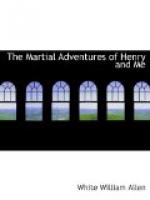We spent one night on our journey along the Italian front at Vicenza, and there, although the place was jammed full of soldiers, we left the war behind to stroll by moonlight over the beautiful mediaeval town. There is a fine square there—not so broad as the square at St. Mark’s where the tourists used to feed the doves, but to me it seemed as beautiful. For upon the square was the famous arcade which Palladio erected around the city-hall of the place. It stood beautiful and gloomy before us in the moonlight, one of the world’s real bits of architecture. As Americans we had a special interest in the arcade because it was typical of the best of Palladio’s work and our own Thomas Jefferson, studying it, had reproduced it and Americanized it in some of the buildings of the University of Virginia, buildings that have had a distinct influence upon American architecture! A number of Palladio’s other works we saw that night, softened and glorified by the moonlight. And we saw also an old French house, not twenty-five feet wide, but a gem of French architecture erected before the discovery of America. Finally we went back and stood by the statue of Palladio and listened to the low rumble of the guns on the front and wondered what the Germans would do with such a lovely thing as this Vicenza if by any chance they ever took it. That day we had looked down from a mountain-top upon an Austrian town lying peacefully in the valley below us directly under the Italian guns. The guns of the Austrians and the Italians were smashing away at each other from the mountain-tops over and across the town.
“You could pulverize that town easily enough,” Henry said to the Italian who was taking the Americans through the trenches.
“Oh, yes,” he answered. “But it’s a beautiful little town! Why ruin it?” His theory was that if the Italians took it they would want it whole and would want the loyalty and respect of the people of the town; if they did not take it, why smash a beautiful little town just to be smashing?




